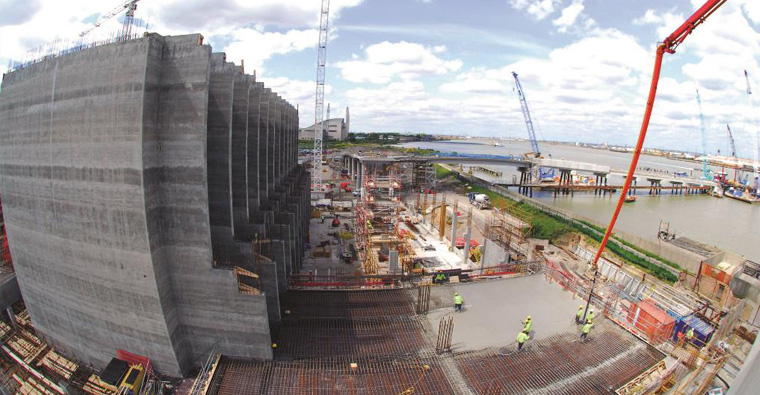
Effectively Combatting Chloride Attack
Chloride attack is one of the primary causes of damage on reinforced concrete structures and independent tests have confirmed that Flexcrete’s Cementitious Coating 851 provides an effective barrier to chlorides for at least 28 years.
In 1988, a 2mm thick film of Cementitious Coating 851 was applied to a concrete slice and sealed in a chloride ion diffusion cell and it is still going strong some 28 years (10,179 days) later. Ongoing tests carried out in the laboratory at the VINCI Technology Centre in Bedfordshire show that the barrier properties of 851 have not changed after a test period spanning the ongoing 28 years.
The Latest Cementitious Technology
Cementitious Coating 851 is a highly advanced, two component, waterborne cementitious modified polymer coating which was originally introduced by Flexcrete Technologies Limited back in 1985, and it still remains one of the most effective products for providing structural protection against chloride attack. 851 is specified on both existing and new structures to waterproof concrete, reinstate concrete cover and provide an effective barrier to chloride ingress, amongst many other challenges typically encountered on buildings, infrastructure and structures in sectors such as coastal, highways and water. A 2mm coating of Cementitious Coating 851 is equivalent to 100mm of good quality concrete cover.
Chris Lloyd, Director of Flexcrete Technologies Limited said: “We have been advised that the performance of Cementitious Coating 851 in this test is unparalleled. Not only has the Cementitious Coating 851 shown minimal permeability and constant yet very low diffusion coefficients, Cementitious Coating 851 has not shown any signs of deterioration despite being fully immersed in the chloride solution for over 28 years. From VINCI’s experience, many coating systems tend to degrade over time when on test in the cell. Even products that initially perform well can subsequently blister, resulting in more chloride ions passing through the product. Following the latest investigations and studies in concrete technology, VINCI’s internal testing can now determine a chloride ion diffusion coefficient from non-steady state conditions.
“Based on the total chloride quantity which has been determined to diffuse through the 851 coating during 28 years on test, it has been calculated that this equates to a chloride ion diffusion coefficient of 8.53×10-13 cm2/s. By comparison for the uncoated reference concrete specimen, a chloride ion diffusion coefficient of 1.03×10-8 cm2/s was calculated based on the total chloride quantity that had diffused in the first 98 days on test when steady state was achieved. To put this in context, it would have taken 270 years for the product cell with the 851 to reach the same chloride concentration that the uncoated specimen reached in just 98 days,” he continued.
Outstanding Protection for Concrete
Cementitious Coating 851 resists 10 bar positive and negative pressure under a 100 metre head, forming a hard, highly alkaline coating which not only protects concrete from the effects of aggressive acid gases, moisture and chlorides, but also has greatly enhanced chemical resistance. It has been extensively used on Crossrail developments including Tottenham Court Road, Liverpool Street and Paddington Stations and all around the world on projects, such as at Abu Dhabi International Airport, the Gorgon LNG Project and Hong Kong’s West Kowloon Expressway. It provides an effective alternative to recasting or even demolition of precast and in-situ reinforced concrete, where the cover to the reinforcement has not been achieved to give the durability to attain the specified design life.
Being cement based, Cementitious Coating 851 chemically reacts with the substrate to form an integral part and will have a design life equivalent to that of the concrete to which it is applied. 851 can be applied to either green or aged concrete by brush or spray techniques, exhibits minimal hazard during application and is non-toxic when cured. It is CE-Marked in accordance with BS EN 1504-2, the pan European standard for concrete repair, and it is also backed by British Board of Agrément (BBA), WRAS and has London Underground approval. In addition, it is approved under Regulation 31(4)(a) for use in contact with drinking water.

